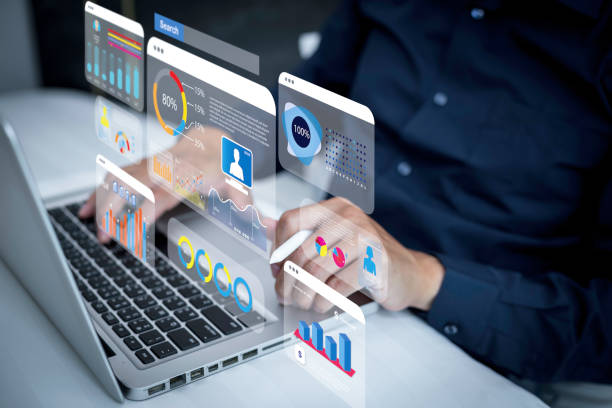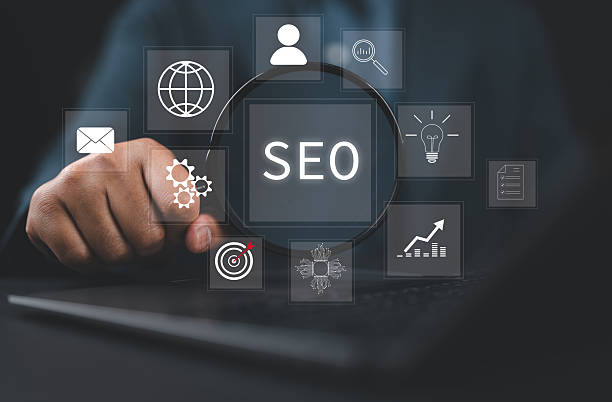Introduction to the Importance of On-Page SEO and Its Place in Optimization

On-Page SEO, sometimes also referred to as internal SEO, is the cornerstone of any website’s success in search engines.
This optimization segment encompasses all actions taken directly on your website pages to improve their ranking in search results.
The importance of #On-Page_SEO lies in having complete control over it; by implementing it correctly, you can send clear signals to search engines that your content is relevant and high-quality.
Unlike off-page SEO, which focuses on external factors like backlinks, on-page SEO involves optimizing titles, meta descriptions, keywords, URL structure, image optimization, and internal linking.
This is an educational and continuous approach that helps your website be more appealing and understandable not only for search engines but also for users.
Without a strong foundation in on-page SEO, even the best off-page SEO strategies cannot succeed on their own.
In fact, these are the preliminary actions that make your content accessible and understandable for search engine crawlers.
This chapter serves as a gateway to the complex yet vital world of on-page SEO, aiming to provide an overview of its importance and central role in search engine optimization.
Many websites, despite having excellent content, remain unseen due to weaknesses in this area.
Tired of your e-commerce website not generating as much revenue as it could? Rasaweb, specializing in professional e-commerce website design, solves this problem permanently!
✅ Increase sales and revenue rates
✅ High loading speed and unparalleled user experience
⚡ Get free consultation for e-commerce website design
Keyword Research for On-Page SEO and Content Strategy

Keyword research is the heart of successful on-page SEO.
This process involves identifying phrases and words that users employ when searching on Google and other search engines to find content similar to yours.
In-depth keyword research helps you not only produce more relevant content but also better understand your target audience.
This specialized step requires tools like Google Keyword Planner, Ahrefs, Semrush, or KWFinder, which provide information on search volume, keyword difficulty, and related keywords.
For on-page SEO, focusing on keywords with user Search Intent is crucial: Is the user looking for information (informational keywords), intending to buy (commercial keywords), or seeking a specific website (navigational keywords)? Understanding this helps you correctly shape your content strategy and ensure your content is explanatory or guiding.
Furthermore, utilizing Long-tail Keywords, which are less competitive yet more targeted, can bring higher-quality traffic to your site.
Your content strategy should be built upon these keywords and designed to answer users’ questions, not just repeat keywords.
This approach is the foundation of strong and sustainable on-page SEO that will show results over time.
Content Optimization in On-Page SEO and Writing Principles

Content optimization is one of the most important pillars of on-page SEO.
After keyword research, it’s time to intelligently incorporate them into your content, without compromising text quality or readability.
The principles of writing SEO-optimized content go beyond merely repeating keywords.
Your content should be thought-provoking content and valuable, addressing the real needs of users.
This includes using the main keyword naturally in the title, the first paragraph, and throughout the text.
Furthermore, using related keywords (LSI keywords) that help search engines better understand the main topic of your content is crucial.
Content structure is also highly important; using appropriate headings (H1, H2, H3, etc.), short paragraphs, lists, and relevant images helps improve readability and user experience.
These actions are not only more appealing to users but also allow search engines to more easily comprehend the structure and topic of your content.
For on-page SEO, keyword density should be natural, and keyword stuffing should be avoided.
On-page optimization means producing content that is optimized for both the user and the search engine.
| Optimization Element | Description and Importance | Best Practices |
|---|---|---|
| Keywords | Words and phrases users use to find content. | Natural use in title, introduction, headings, and body text. |
| Headings (H1-H6) | Content organization and improved readability for users and crawlers. | Logical use of H1 for the main title and H2-H6 for subtitles. |
| Text Readability | Ease of understanding and reading content for users. | Short paragraphs, simple sentences, use of lists and bullet points. |
| Visual Content | Images, videos, and infographics that help better understand the content. | File size optimization, use of descriptive and relevant Alt Text. |
| Content Freshness and Updates | Providing new and relevant information over time. | Periodic review and update of old content with new information. |
The Role of Title Tags and Meta Descriptions in On-Page SEO

Title Tags and Meta Descriptions are two vital elements in on-page SEO that directly impact the Click-Through Rate (CTR) of your pages in search results.
The title tag is the title that appears in the browser tab and as the largest and most prominent text in search results.
This tag should include the page’s main keyword, be attractive and persuasive, and have an appropriate length (usually less than 60-70 characters) to be fully displayed.
A good title tag not only helps search engines understand the page’s topic but also encourages users to click.
The meta description is a short, descriptive summary of the page’s content displayed below the title tag in search results.
Although the meta description is not directly a ranking factor, it plays a very important role in persuading users to click on your link.
It should include the main keyword and a Call to Action, showcasing your content’s appeal within approximately 150-160 characters.
Together, these two elements form the user’s first impression of your page and can significantly impact your on-page SEO performance.
Careful crafting of these tags demonstrates a specialized approach to optimization.
Losing potential customers due to an unprofessional website? Rasaweb is your answer! With our specialized corporate website design services:
✅ Enhance your business’s credibility and standing
✅ Experience attracting more targeted customers
⚡ Act now to receive a free consultation!
The Importance of URL Structure and Internal Linking

URL structure and internal linking are two other important factors in on-page SEO that are often overlooked.
An optimized URL is short, descriptive, and includes keywords relevant to the page’s content.
Readable and logical URLs help both users anticipate page content and search engines understand the website’s structure and content hierarchy.
Using keywords in the URL sends a strong signal to search engines.
Alongside optimized URLs, internal linking is crucially important.
Internal linking means creating links between different pages within a website.
This has several benefits: Firstly, it helps users easily navigate your site and find related pages, which improves user experience.
Secondly, it helps search engines discover new pages and understand the importance and relationships between different pages.
Thirdly, it distributes SEO power (Link Equity) across your website, meaning your more important pages benefit from more internal links and achieve better rankings.
For on-page SEO, using descriptive and relevant Anchor Texts in internal links is very important.
This is a guiding approach that helps search engines better understand the content of target pages, ultimately leading to an improvement in the overall website ranking in search results.
Image Optimization and Site Speed for On-Page SEO

Image optimization and site speed are two technical but very crucial aspects of on-page SEO that directly impact user experience and search engine rankings.
Images, while important for visual appeal and conveying messages, can significantly slow down page loading due to large file sizes.
To optimize images, suitable formats (like WebP for web), loss-less compression, and correct dimensions should be used.
Furthermore, filling the Alt Text for images with relevant keywords not only helps search engines understand image content but is also beneficial for visually impaired users.
This is a specialized action that also helps increase visibility in image search.
Site speed is an important ranking factor, and slow websites can lead to high bounce rates and poor user experience.
Tools like Google PageSpeed Insights help you identify and resolve site speed issues.
Factors such as code optimization (CSS, JavaScript), browser caching, using a CDN (Content Delivery Network), and choosing suitable hosting all play a role in improving site speed.
A fast site not only provides a more engaging user experience but also signals to search engines that your site is high-quality and reliable.
The combination of image optimization and site speed is a fundamental step in improving overall on-page SEO performance and helps your site lead in competition with other sites.
The Role of Structured Data (Schema Markup) in Improving On-Page SEO

Structured data, or Schema Markup, is code added to your site’s HTML that helps search engines better understand your page’s content.
This code provides search engines with information about the type of your content (e.g., a product, an article, an event, a recipe, or a local business) and its relevant details.
Using Schema Markup does not directly change your ranking in search results, but it allows search engines to display richer information in search results (Rich Snippets).
This thought-provoking content is more visited than regular results and can significantly increase your Click-Through Rate (CTR).
For on-page SEO, correctly implementing structured data is a specialized step.
For example, if you have an article blog, you can use Schema.org/Article to highlight the title, author, publication date, and article image.
If you are an online store, Schema.org/Product can display information such as price, availability, customer ratings, and reviews.
This helps users get more information about your product or content before clicking and make a more informed decision.
This type of optimization signifies a deep and advanced approach to SEO optimization that can drive targeted, high-quality traffic to your website and contribute to its significant growth.
| Schema Markup Type | Application Example | SEO Benefits |
|---|---|---|
| Article | Blog posts, news articles, scientific articles | Display of information such as author, publication date, and image in Rich Snippets. |
| Product | Online store product pages | Display of price, availability, star ratings, and customer reviews. |
| Review | User reviews about products, movies, books | Display of overall ratings (stars) in search results. |
| FAQPage (Frequently Asked Questions) | Pages containing a list of frequently asked questions and answers | Increasing occupied space in SERP by directly displaying answers. |
| LocalBusiness | Pages related to physical businesses | Display of address, opening hours, contact number, and map in local search results. |
User Experience (UX) and Its Impact on On-Page SEO
![]()
User Experience (UX) has become one of the most important factors in on-page SEO in recent years.
Google and other search engines are increasingly focusing on user interaction with websites and reward sites that offer a better user experience.
Factors such as Bounce Rate, Dwell Time, number of pages visited per session, and Conversion Rate are all important UX indicators that affect your on-page SEO ranking.
A website with a responsive design that displays well across various devices (mobile, tablet, desktop), a logical sitemap and easy navigation, readable and engaging content, and clear calls to action, all contribute to improving user experience.
This is an analytical and comprehensive approach.
Engaging and useful content keeps users on your site longer and increases their likelihood of returning.
Sites that users are not satisfied with have high bounce rates and send negative signals to search engines.
Therefore, investing in UX design not only leads to improved customer satisfaction but also indirectly has a positive impact on your on-page SEO.
Ultimately, the goal of SEO is to provide the best and most relevant results to users, and if your website offers a good experience, search engines will recognize it and elevate its ranking.
Does your current e-commerce website design lead to losing customers and sales?
Rasaweb is your solution with modern and user-friendly e-commerce website designs!
✅ Significant increase in conversion rates and sales
✅ Creating strong branding and gaining customer trust
⚡ Get a free consultation for e-commerce website design from Rasaweb!
On-Page SEO Analysis and Monitoring Tools

To ensure the effectiveness of your on-page SEO strategy, continuous performance monitoring and analysis are essential.
Various tools are available to help you examine your website’s on-page SEO status, identify issues, and discover opportunities for improvement.
Google Search Console (GSC) is one of the most important and free tools provided by Google itself.
This tool provides valuable information about how your website is crawled, indexed, and displayed in search results.
You can receive reports on coverage issues, keyword performance, internal and external links, and sitemaps.
Google Analytics is also a vital tool for understanding user behavior on your site.
This tool provides analytical and precise information about traffic, traffic source, bounce rate, dwell time, and user paths on your site, all of which can contribute to improving on-page SEO.
In addition to these free tools, paid and specialized tools like Ahrefs, Semrush, Moz Pro, and Screaming Frog also provide advanced features for comprehensive SEO analysis (including keyword analysis, competitor monitoring, technical site health checks, and on-page SEO audits).
Regular use of these tools to monitor progress and identify weaknesses is an integral part of a successful on-page SEO strategy, helping you make data-driven decisions for future optimizations.
This is a news-oriented and constantly updating approach in the ever-changing world of SEO.
Common Mistakes in On-Page SEO and How to Avoid Them
![]()
Even the most experienced SEO professionals can make mistakes in on-page SEO.
Identifying and avoiding these common mistakes can significantly impact the success of your on-page SEO strategy.
One of the biggest mistakes is Keyword Stuffing, or excessively filling the text with keywords.
This not only ruins the user experience but can also lead to penalties from search engines.
The solution is to focus on content quality and naturalness.
Another mistake is neglecting site speed and mobile optimization.
Given the increasing use of mobile for search, lack of mobile optimization can lead to losing a large portion of the audience.
Also, the failure to use optimized title tags and meta descriptions, or duplicating them across different pages, is another common mistake.
Each page should have a unique and appealing title tag and meta description.
Poor internal linking, including a lack of internal links or using non-descriptive anchor texts, prevents the spread of link authority throughout the site and the discovery of new pages.
Finally, producing low-quality or duplicate content is also one of the biggest obstacles in on-page SEO.
Search engines prioritize original, comprehensive, and valuable content.
Avoiding these mistakes and adopting an analytical and precise approach at every stage of on-page SEO can set your website on the right path to achieving high rankings in search results and contribute to sustainable growth.
This is a comprehensive guide to preventing common problems.
Frequently Asked Questions
| Question | Answer |
|---|---|
| What is a Meta Title and why is it important in on-page SEO? | The meta title is the most important on-page SEO element, displayed at the top of the browser tab and in search results. It helps search engines and users understand the main topic of the page and should include the main keyword. |
| What role does the Meta Description play in on-page SEO? | The meta description is a short summary of the page’s content displayed below the title in search results. Although it doesn’t directly influence ranking, its appeal can increase the Click-Through Rate (CTR). |
| How should keywords be used in page content? | Keywords should be used naturally and relevantly in strategic locations such as the title, headings, first paragraph, and body text. Avoid excessive keyword stuffing. |
| What is the importance of high-quality and comprehensive content in on-page SEO? | High-quality, unique, informative, and comprehensive content that addresses user needs is of great importance. Search engines give higher rankings to content that creates real value. |
| What is the use of heading tags (H1-H6) in on-page SEO structure? | Heading tags (H1, H2, H3, etc.) are used to structure content and indicate the importance of different sections. H1 is the main title of the page, and each page should only have one H1. Other tags are used for subtitles. |
| How to optimize images for improved on-page SEO? | To optimize images, use descriptive Alt Text that includes relevant keywords, reduce image file size without compromising quality, and use meaningful and relevant file names. |
| What are the characteristics of an SEO-friendly URL for on-page SEO? | An SEO-friendly URL should be short, readable, descriptive, include main keywords, and be free of extra characters. The URL structure should be hierarchical and logical to be understandable for both users and search engines. |
| How does Internal Linking help on-page SEO? | Internal linking, by connecting related pages, helps users and search engine crawlers better understand the site structure, transfer page authority, and increase user dwell time on the site. |
| What is the impact of page loading speed on on-page SEO? | High loading speed is vital for both user experience and SEO ranking. Slower pages might be overlooked by search engines and lead to an increased Bounce Rate. |
| Why is Mobile-Friendliness highly important in on-page SEO? | Given the ever-increasing number of searches via mobile devices, having a responsive and mobile-friendly site is essential for user experience and ranking in search results (Google’s mobile-first indexing). |
And other services of Rasaweb Advertising Agency in the field of advertising
Smart Brand Identity: Revolutionize customer acquisition with user experience customization.
Smart Custom Software: Designed for businesses seeking to increase click-through rates through SEO-driven content strategy.
Smart Marketing Automation: A professional solution for analyzing customer behavior with a focus on custom programming.
Smart Brand Identity: A dedicated service for growth in click-through rates based on attractive user interface design.
Smart Website Development: Revolutionize customer acquisition with marketing automation.
And over hundreds of other services in the field of internet advertising, advertising consultation, and organizational solutions.
Internet Advertising | Advertising Strategy | Advertorials
Resources
Comprehensive On-Page SEO GuideKey Content Optimization Tips for SEOTechnical SEO TrainingIntroduction to Essential SEO Tools
? To make your business shine in the digital world, from personal website design to comprehensive marketing campaigns, Rasaweb Afarin Digital Marketing Agency offers creative and results-driven solutions.
📍 Tehran, Mirdamad Street, next to Bank Markazi, Kazeroon Janoubi Alley, Ramin Alley No. 6

